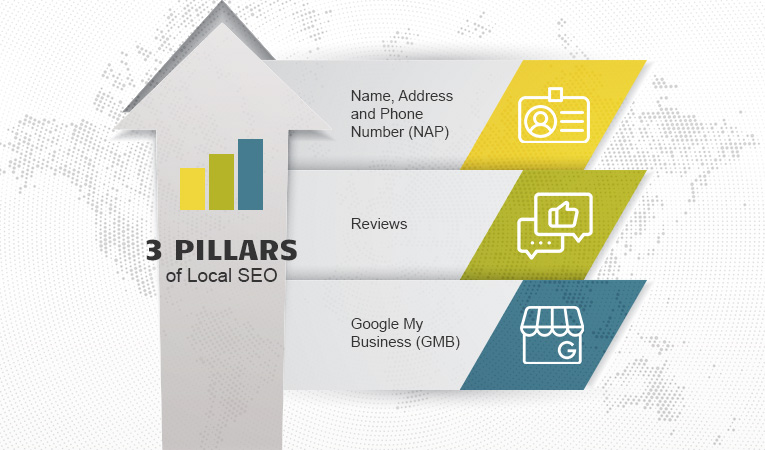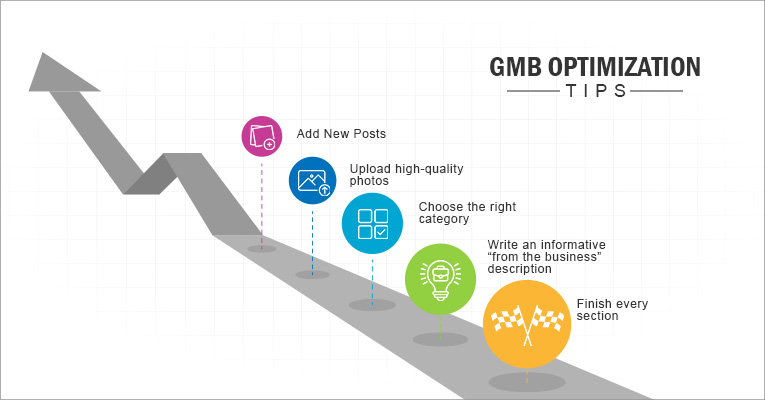Local SEO can be hard to master for small business owners. This is because there are so many factors contributing to a strong SEO strategy. It can be hard to research proper local SEO tactics because you’re likely to run into a lot of conflicting information. It can be hard to know where to start, but there are three pillars of local SEO savvy business owners and marketers alike tend to focus on:
- Name, Address and Phone Number (NAP)
- Reviews and
- Google My Business (GMB)

Here we break each pillar down, to help you understand how they work together to create a solid local SEO foundation.
Why is NAP So Important?
NAP stands for Name, Address, and Phone Number. While this might seem like pretty basic stuff, your NAP can appear in the places you know of, as well as places you don’t even realize exist. Every time your NAP appears online, it becomes a “citation.” Search engines use citations as a form of authority for local small businesses.
So, the more citations you have, the more authoritative you seem, and the higher you can rank on search engines. But here’s the rub: If your NAPs aren’t consistent across all your citations, then it confuses search engines and can actually ruin your authority. So how do you ensure your NAPS are consistent? That brings us to the next pillar, Google My Business.
How Does GMB Impact NAP?
It all begins with claiming your Google my business profile (GMB). Your Google profile is the base directory other directories and search engines use to find you. Therefore, you need to make sure your NAP is correct and complete on GMB. Make sure you use the same NAP on all online marketing business accounts including your website, social media, and business directories.
By this, we mean actually checking every single instance where you have provided your NAP to make them all exactly the same. You might be surprised how many iterations you can find. A perfect example is something as simple as Street appearing as St or St. Something as seemingly innocents at this can confuse search engines, so citations aren’t associated with your business. However, you might also find out and out mistakes such as the wrong street or phone number.
It is worth the effort to correct your NAPs so they are all consistent. Although it might seem unnecessary, write out the address you plan to use, and refer to it for every new marketing account you open. Other places to check your NAP include Yelp and Yellow Pages as well as any listings specific to your location or industry.
How Does Your GMB Affect SEO?
You also have to review your entire GMB profile to look for instances of random information and errors. GMB offers you the chance to have a very thorough overview of your business online. You want it to be as complete as possible. Because Google populates sections you haven’t completed you could be placed in the wrong category or have an inaccurate description. As a small business owner GMB is one of the simplest and most affordable digital marketing tools at your disposal. You can optimize your GMB using the following tips:

Finish every section
We’ve already discussed the importance of your NAP, but your GMB profile includes several sections. You should complete every section with as much detail as the platform allows as this is the best way to capture more leads. Don’t go into your profile expecting to finish it quickly. Instead set aside time so you can provide thorough information for your products and services, choose the most suitable category, and add the best business attributes.
Write an informative “from the business” description
There is a brief business description Google adds for every business. Unfortunately, this section isn’t editable. However, there is also the opportunity to write the “from the business” description yourself. You’ve got 750 characters to contribute here, so take advantage of them using a condensed version of your website’s About Us section. Include keywords and don’t be repetitive with information you’ve already provided in your profile. This is where you can focus on your unique value proposition with a little bit more insight into why your customers love you.
Choose the right category
It can be frustrating choosing a category as the list is long and might not have exactly what you want. However, there should be a term that works and that will help Google find you. You can then hopefully find category-specific features that help. You can also choose a secondary category, which allows you to include more descriptive details about your services to help attract the right customers. Be sure to avoid creating confusion by stretching too far on the details. This actually can create a disconnect with customers. Your descriptive details need to make sense to customers and Google.
Upload high-quality photos
Take your time choosing the photos you upload. Use professional-quality photos that show off your brand in the best possible light. Continue to upload new photos to keep customers engaged and show your business is always on the go. A new photo once a week or so will suffice. When choosing your cover photo make sure it is relevant and never use stock photos. They tend to stick out like a sore thumb. To get more local attention, geo-tag your photos and if you can add videos.
Add New Posts
GMB offers a posting option much like social media. This is the best place to announce new products, special offers, a change of hours, etc. as it is front and center on the search results.
Nothing is better for your local SEO than your GMB profile. It is free, and it works.
Why Do You Need to Monitor Online Reviews?
Online reviews are a pretty scary prospect for small businesses and for good reason. You really have no idea of what you might do to set someone off. However, if you take the approach that what you don’t know can’t hurt you, you are asking for trouble. Monitoring your online reviews is a must for every small, local business. When you see negative comments, you have the opportunity to reply and help keep people happy. The longer a bad review sits online unanswered, the worse it is for your online reputation. Your reviews are actually twofold:
1. Dealing with bad reviews
You need to keep an eye on bad reviews and respond to them immediately. This is very important because it shows people reading reviews you care, and that you did something to ensure the customer was happy. While you might still find some people are never satisfied, when you are there to respond, you have a chance to bring most people around. You often get the chance to have them change their rating and review into something positive. It’s like making lemonade out of lemons.
2. Asking for positive reviews
This is embarrassing the first few times, but can soon become a very good habit. You know you are providing a quality product or service, so should be using that to create a very strong positive online reputation. After each product is delivered or service is complete, email a link inviting satisfied customers to fill out a review and/or rate you. This is the best time to approach them when the experience is still fresh in their minds. Satisfied customers are usually happy to oblige. You can then share good reviews on social media, and use them to create testimonials on your website. And remember, always comment on positive reviews as well. It shows your customers they are appreciated.
Do both of these things well, and you will see a difference in your ranking and leads.
Let’s check out few important stats on Online Reviews:
- According to BrightLocal, 93% of customers will read reviews of local businesses to determine its quality.
- According to Broadly, customers spend 31% more time when a business has excellent reviews.
- As per Moz, Review Signals account for about 15.44% of the method Google uses to rank local businesses.
- As stated by ReviewTrackers, 53% of customers expect businesses to respond to negative reviews within a week.
- As per G2.com, 92% of B2B buyers are more likely to purchase after reading a trusted review.
- According to Podium, the average star rating required for a consumer to consider engaging with a business is 3.4.
Off-page on On-Page SEO
In addition to these pillars, your digital marketing efforts need to consider on-page and off-page SEO. This can be a little hard to wrap your head around, but it can be done with a little help from the pros. On-page SEO is the toughest, as it includes the technical aspects of your SEO strategy in hand with perfecting your website design and content.
Off-page SEO establishes what is called domain authority. The more inbound links you have, the more authority Google feels you have. The trick is getting high-quality inbound links from other authoritative sites. While citations are a form of off-page SEO, they don’t really have a lot of authority behind them as they just mention your NAP. However, when the links are connected to a site with authority, your domain authority rises. One of the easiest ways to get inbound links is to offer to provide guest blogs to other local companies. This is also a great way to network with local businesses which in itself is a great marketing strategy. Many local businesses are happy to list fellow business owners’ website links, and you can do the same.
The truth of the matter is, local SEO isn’t something you can learn overnight. While understanding the three pillars can help, local SEO is often too much to handle alone. Our team of SEO experts would be happy to help you with your digital marketing strategy. Contact us to get started!
